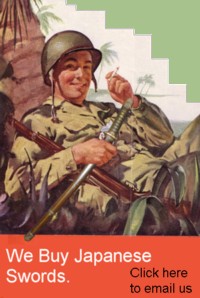WWII JAPANESE ARMY SAMURAI SWORD - KATANA - #4 -
This sword is a fine example of a WWII era Katana which was machine
produced. The fittings of the sword are typical of the Imperial Japanese Army. The Katana sword
was developed during the Momoyama period. The main purpose was to allow the Samurai to fight
from horse back. It's length is normally between 24" to 30".


|
The Samurai sword has a very rich history. The sword has been manufactured for several centuries and continues
to be produced today. The sword represented more than just a weapon. It was the soul of the Samurai warrior.
When attempting to identify the type of sword you have It is important to keep in mind that the fittings of
a sword (scabbard, handle, crossguard. etc.) may be identical from one sword to another. The reason why is
because during WWII the same fittings were used in all Army swords, Navy swords, etc. Armed forces are all
about uniformity. They strive to make everything the same.
This is the reason why a sword cannot be identified merely by its external appearance.
Understanding the different components that make up the Samurai sword is the first step in figuring out the
type of sword you have. That is the reason why we have created the
Understanding the Samurai sword section as a means to
provide a novice with the basic knowledge to start the path of determining the questions everyone has;
who made the sword, how old it is nad how much it is worth.
|
The pictures left side picture below shows a military sword suspension loop. This sword was outfitted with
a very plain hand guard (Tsuba), as depicted in the center picture below.
The picture on the right hand side displays a sword tip with a cherry blosom pattern.
The pictures that follow provide a closer look at the locking mechanism of the sword. These are the
components which secure the blade to the scabbard.
The picture on the right shows the release button with a leaf design on either side of it.
The picture on the left shows a triangular shape opening which is where the blade slides
through.



|
This page is a recognition and identification guide for Samurai swords.
Multiple detailed photos of a specific sample are provided. Descriptions point
out clearly defined points that should be noted.
One of the most commonly asked questions is "How much is my Samurai Sword worth?".
A price guide is included here to address this question. The value of the swords is
reviewed over a period of several years. A trend can be observed. The present worth
of the edge weapons in the collector's market is illustrated.
This service is provided free of charge to the visitor/enthusiast courtesy of
MilitaryItems.com,
a company dedicated to the preservation of military history and to providing quality
military antiques and collectibles to museums, institutions and the general public.
|
|

|
The base ring was named the Fuchi. It was normally decorated to match the pommel and the Tsuba. The purpose of the Fuchi
was to hold the locking release button in place.
The sword automatically locks in place when it is secured in the scabbard. The lock release button must be pressed to
take the sword out.
|

|

|
WE BUY JAPANESE SWORDS - All types of Japanese edge weapons. Whether it is a WWII era Samurai sword or an
older type of blade.
The process gets started by you sending us an
Email .
We will respond to your inquiry normally within 24 hours and in many cases much faster.
We can tell you what you have, what it is worth and how much we can pay you.
One sword or an entire collection -
Email Us .
|
 |
The two pictures below depict two different areas where the arsenal markings were placed on the swords.
The picture on the left has the marking stamp on the bottom far left side of the tang.
The other picture shows a marking stamped on the top of the blade, near the starting point of the tang.
These markings are known as Seki stamps and indicate that the sword was made in factory. The blade was
machine made.


Even though the blade was machine made, the tang of the sword has been signed. The markings are placed in both sides of the tang.
One side has multiple characters that provide information abou the manufacturing date. The other side has two characters which
indicate the name of the swordsmith that worked on the blade.
Additional markings are added to the blade by painting characters with white paint. These charactes were placed at the
factory and indicate production numbers. painted.


This sword was built with a double-hole tang. One is placed by the base and the other near the end. Wooden pegs would rest
on the holes and ensure that the handle is secured firmly to the blade. This sword is the original size as when it was
manufactured. It was never shortened.


By the Numbers
It is next to impossible to determine the exact number of Samurai swords that were produced and issued to
Japanese soldiers during the war. However, thanks to the record keeping maintained by the US Armed Forces,
it is possible to estimate how many swords were actually shipped home.
 |
There were over 500,000 Samurai swords were brought back home as souvenirs from the war.
There are several caviats to this number.
|
 |
For example, some soldiers took souvenirs and shipped them home circumbenting the established process.
Some of the swords were brought back inside duffle bags without anyone knowing except for the soldier who
captured the sword. This fact would clearly affect the final count.
The number also does not account for swords that were taken by Allied soldiers from other countries.
Collecting Samurai swords
Collecting Samurai swords is a field that has been growing since the days the GI's rummaged around Asia
bringing back military souvenirs. Japanese soldiers carried many of these swords when they went to
battle. Once the soldier was killed or captured, the Americans would take the edge weapons as war trophies.
Eventually all these pieces came back to the United States where military history enthusiasts began to collect them.
 |
In trying to determine if you should collect Samurai swords there are certain factors that should be
considered.
The adjacent table outlines some of the advantages and disadvantages of collecting the Samurai swords.
|
 |
This Samurai Sword may be currently reproduced.
It is becoming more difficult to be able to tell the fake ones from the real ones because
the quality of the reproductions is improving. The collector must become familiarized with
the construction style and materials employed in the manufacturing of this item.
Attention to the details is critical in order to be able to determine the authenticity of
the collectible.
If you have an interest is seeing other Japanese Samurai swords, you can do so by going to our
Japanese Samurai Swords Price Guide
identification guide. Where we cover Samurai swords from all periods.
| 




